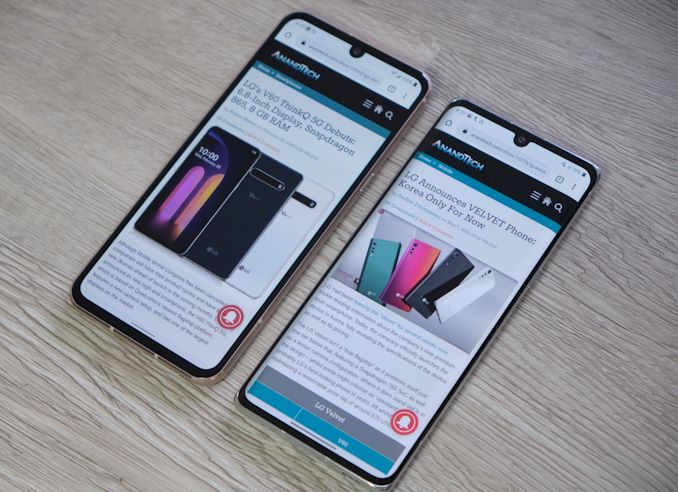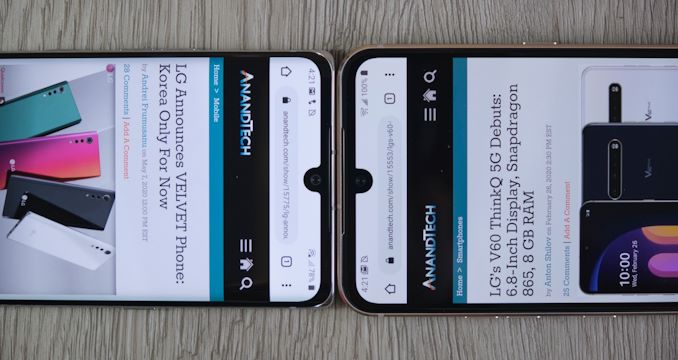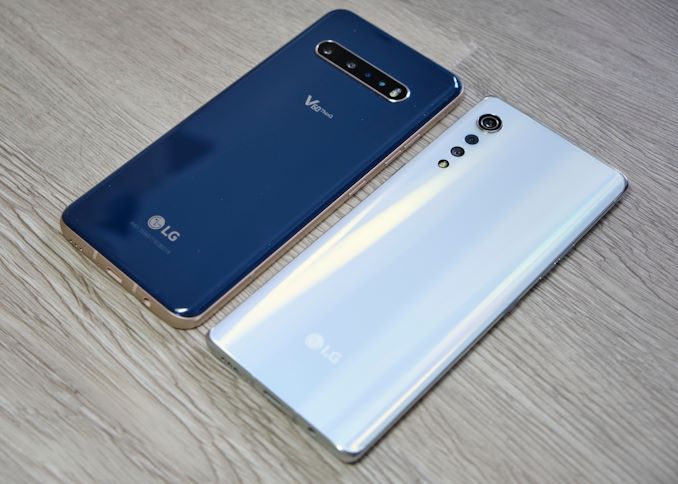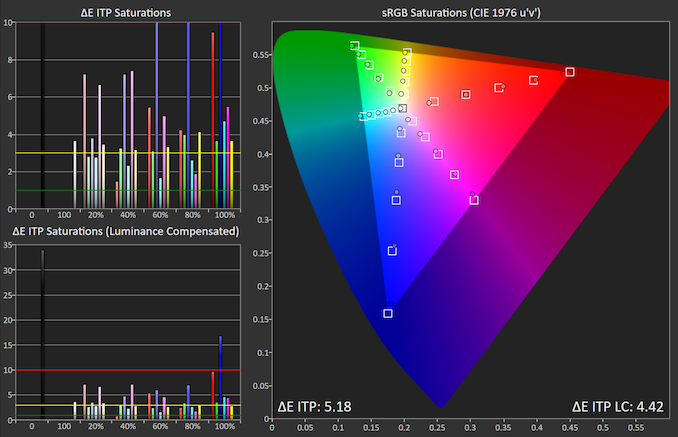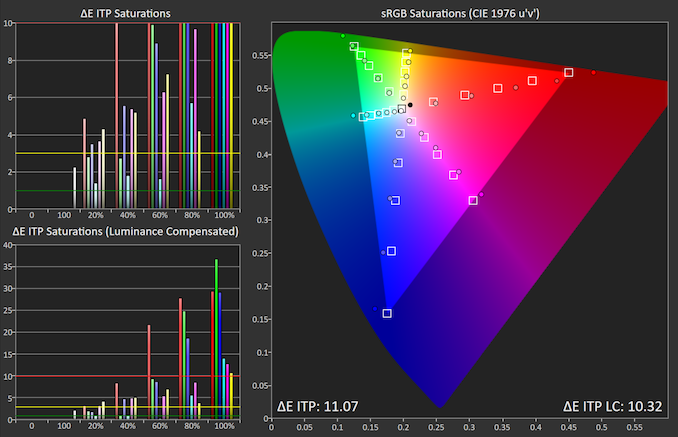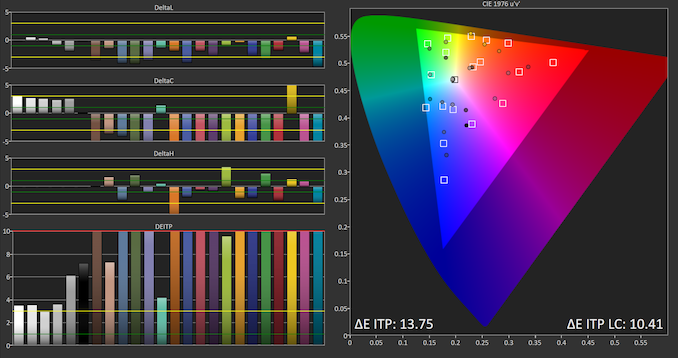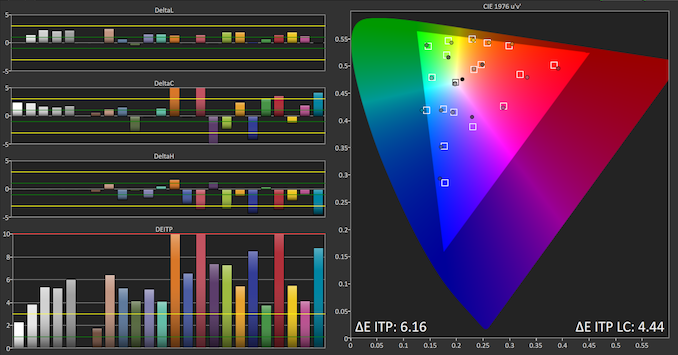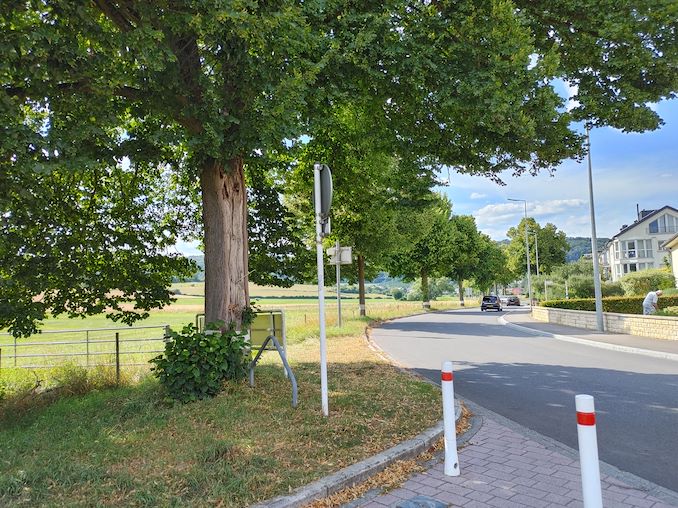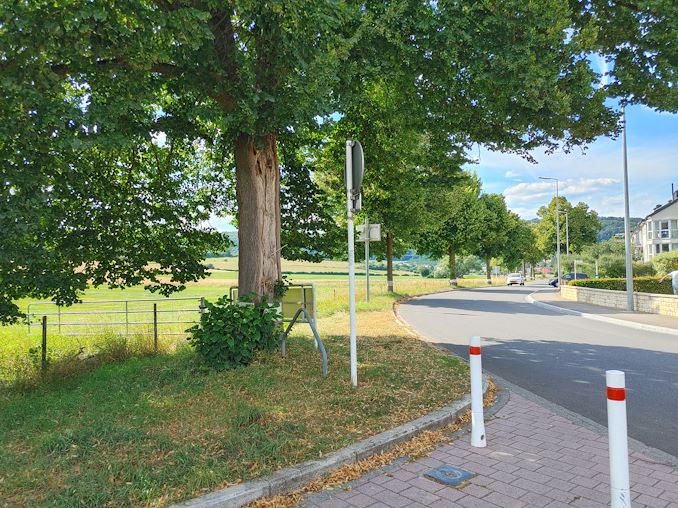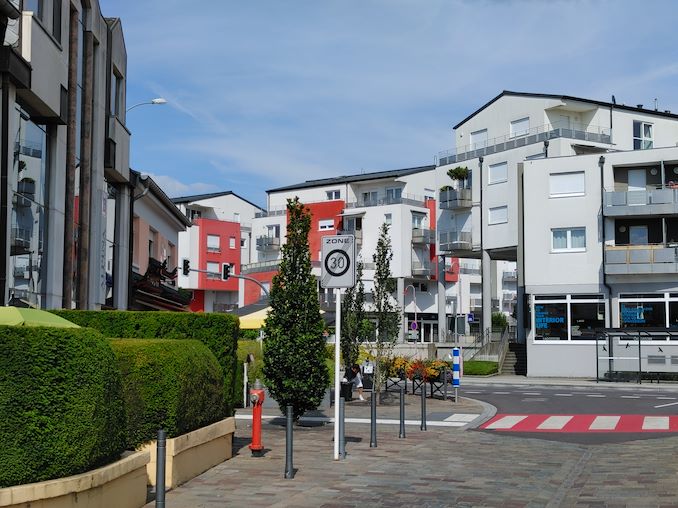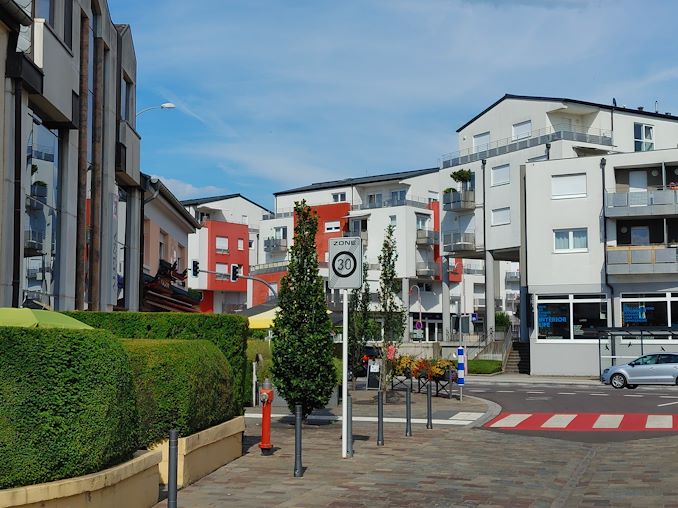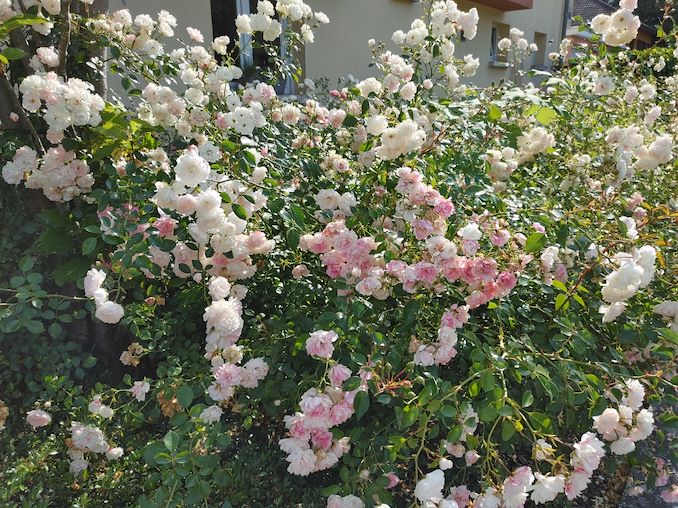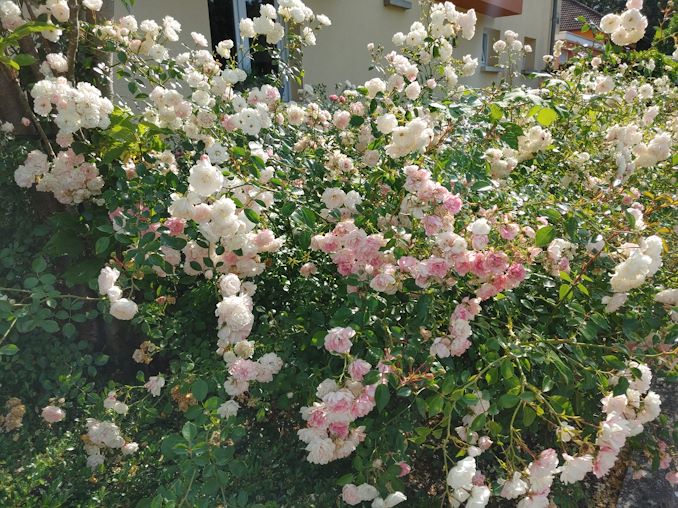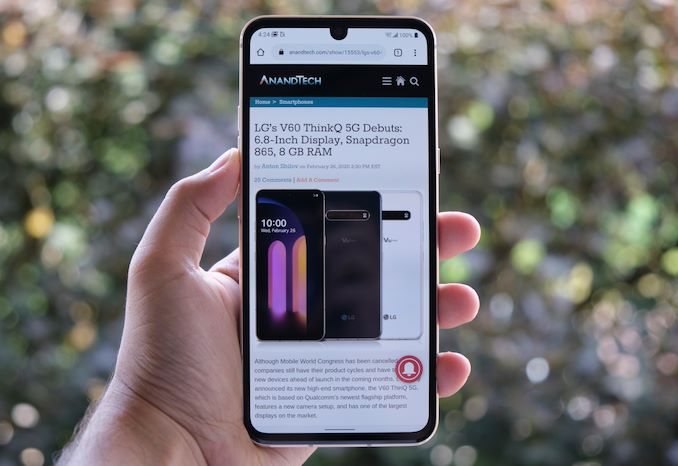
Original Link: https://www.anandtech.com/show/15905/the-lg-v60-and-velvet-review-a-classic-design-restart
The LG V60 and VELVET Review: A Classic & A Design Restart
by Andrei Frumusanu on July 15, 2020 9:00 AM EST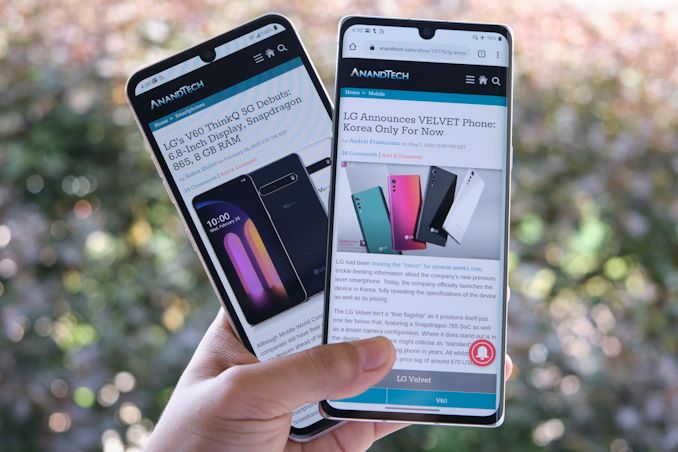
It’s been a few months since LG has released the LG V60, and since then the company has also finally managed to launch the new Velvet phone to western markets outside of Korea, such as Germany. The two new 2020 phones are quite contrasting devices for LG – representing what one could say the company’s classic design philosophy versus a newer, more refreshing design language. They’re also contrasting devices in terms of their specifications and positioning, with the V60 being a successor flagship devices with a high-end SoC, whilst the new Velvet is a “premium” design with the new Snapdragon 765, coming at a lower price point and some compromises in terms of specification – but not too many as to call it a mid-range phone.
Both phones are overdue a closer look, and that’s precisely what we’ll be doing today.
| LG 2020 Flagships | |||
| V60 | Velvet | ||
| SoC | Qualcomm Snapdragon 865 1x Cortex-A77 @ 2.84GHz 3x Cortex-A77 @ 2.42GHz 4x Cortex-A55 @ 1.80GHz |
Qualcomm Snapdragon 765 1x Kryo 475 (CA76) @ 2.3GHz 1x Kryo 475 (CA76) @ 2.2GHz 6x Kryo 475 (CA55) @ 1.8GHz |
|
| GPU | Adreno 650 @ 587MHz | Adreno 620 | |
| DRAM | 8 GB | 8 GB | |
| Storage | 128 GB UFS 2.1 +microSD |
128 GB UFS 2.1 +microSD |
|
| Display | 6.8" FullVision OLED 2460 x 1080 (20.5:9) |
6.8" FullVision OLED 2460 x 1080 (20.5:9) |
|
| Size | Height | 169.3 mm | 167.2 mm |
| Width | 77.6 mm | 74.1 mm | |
| Depth | 8.9 mm | 7.9 mm | |
| Weight | 218 grams | 180 grams | |
| Battery Capacity | 5000 mAh (Typical) | 4300 mAh (Typical) | |
| Wireless Charging | Qi | Qi | |
| Rear Cameras | |||
| Main | 64 MP 1/1.7" 0.8µm f/1.8 w/OIS |
48MP f/1.8 w/OIS |
|
| Wide | 13 MP 1/3.4" 1µm f/1.9 117° super-wide angle |
8MP Super-wide angle |
|
| Extra | ToF 1/4" 14µm f/1.9 117° super-wide angle |
5MP Depth |
|
| Front Camera | 10 MP 1/3.1" 1.22μm f/1.9 |
16MP | |
| I/O | USB 2.0 Type-C 3.5mm headphone jack Under-screen Fingerprint reader |
USB 2.0 Type-C 3.5mm headphone jack Under-screen Fingerprint reader |
|
| Wireless (local) | Wi-Fi 6 Bluetooth 5.1 |
Wi-Fi 6 Bluetooth 5.1 |
|
| Cellular | GSM, CDMA, HSPA, 4G/LTE, 5G | ||
| Splash, Water, Dust Resistance | IP68 | IP68 | |
| Dual-SIM | nano-SIM | nano-SIM | |
| Launch OS | Android 10 | Android 10 | |
| Launch Price | $899 | 599€ | |
In terms of specifications and the brains of the devices, as mentioned, the LG V60 is a familiar phone as it’s simply sporting the best of the best. The Snapdragon 865 features four Cortex-A77 cores, one of which clocks in at up to 2.84GHz and three others at up to 2.42GHz, paired with four low-power Cortex-A55 cores at 1.8GHz. We’ve seen excellent performance and power efficiency out of Qualcomm’s latest chipset in other 2020 flagship devices, and the LG V60 is pretty much in line with the pack in terms of performance and efficiency.
The LG Velvet on the other hand is amongst a smaller number of devices which make due with Qualcomm’s new Snapdragon 765 SoC. This “premium” model functionally has the same level of features as the flagship Snapdragon 865 SoC, but just comes at lower performance levels. In terms of IP, we find two Cortex A76 cores, one up to 2.3GHz and another up to 2.2GHz, paired with six low-power Cortex-A55 cores at 1.8GHz. The GPU in the form of the Adreno 620 is also smaller than the bigger brother’s Adreno 650 configuration.
What’s special about both these SoCs is that they’re 5G enabled. The LG V60 makes use of an external X55 modem for connectivity, while the Velvet integrates its modem capabilities inside of the Snapdragon 765.
Both phones feature 8GB of RAM (LPDDR5 for the V60 and LPDDR4X for the Velvet), and feature 128GB of storage, expandable via microSD slots.
In terms of designs, both phones are very different to each other. The one thing they share in common is the display specifications; both phones feature 6.8” 2460 x 1080 OLED displays. The resolution doesn’t surprise too much for the Velvet as it’s a lower priced phone, but it is quite weird to see LG go backwards on the V60, offering a downgrade from the 1440p resolutions of previous, smaller, V-series phones. There are battery life considerations here which we’ll discuss in more detail later, but it does stretch out quite a bit for displays of these sizes.
Both displays still make use of “dewdrop” notch designs and the cut-outs here are virtually identical between the two phones. The Velvet tries to smooth out the bezel corner near the cut-out via blacked out pixels, but other than that I wouldn’t be surprised if these were actually the same display panels.
Of course, the immediately visible difference between the two phones is their bezel designs. The V60 has a very classic look to it; a flat screen with some quite sizeable side bezels and a chamfered metal frame. The Velvet on the other hand is a lot more contemporary, employing a curved front screen design on its sides, with only a thin glossy metal frame.
You could argue that the V60 looks a lot more industrial, but for me the ergonomics of the Velvet are immeasurably better – it’s not only a physically narrower phone, but it just feels much better in hands thanks to its curvatures as well as thinner form-factor.
Despite the fact that the screen diagonals on both phones are identical, and maybe even have the same panels, the Velvet is a much handier phone. There’s also a big weight difference between the two units, as the V60 comes in at a hefty 218grams versus the Velvet’s 180g. Admittedly, the V60 uses a bigger 5000mAh battery whilst the Velvet is 14% smaller at 4300mAh (which is still respectable).
On the camera side of things, besides the SoC, it’s also where we see bigger differences between the two phones capabilities. The LG V60 has a new generation and larger 1/1.7” main camera sensor coming in with 64MP resolution, with a quad-Bayer colour filter layout binning down to 16MP in regular photos. LG uses this module’s high native resolution to achieve lossless 2x zooming – a necessity as the phone lacks a dedicated telephoto module.
The Velvet uses a similar method, albeit with a 48MP primary camera sensor that’s physically smaller in size than that of the V60’s.
In terms of ultra-wide-angle modules, the V60 features a 13MP sensor while the Velvet makes due with a mere 8MP unit. Besides price considerations, I think the Velvet might be limited by the thickness of the phone here and the deployable sensor sizes, as the phone lacks any protrusions with the UWA module sitting flush with the back glass panel (The main camera does have a small bump).
There’s also an extra ToF sensor on the V60, and unspecified 5MP depth sensor on the Velvet – both don’t actually serve as capturing modules but augment the capture abilities of the phones in modes such as portrait mode.
At the bottom of the phones, we see a similar setup of 3.5mm headphone jack, USB-C port and a three-holed bottom speaker setup (The top earpieces also serve as stereo speakers for playback). The fact that these phones still include the 3.5mm headphone jacks in 2020 makes them actually stand out to the rest of the competition who had opted to drop the useful connector in favour of profit making selling wireless audio accessories. Good on LG for sticking with their ethos.
Overall, the phones in terms of design are quite contrasting, and if you wouldn’t be familiar with them nor see their brandings, it would be hard to believe that they’re actually from the same company, released only a few months apart from each other. LG has had considerable trouble with the industrial design over the last few generations and the V60 is pretty much a continuation of that “outdated” look. The new Velvet is a fresh breath of air and I feel it actually belongs in 2020, its ergonomics are substantially better and the build quality is I feel higher than that of the V60, a bit ironic given that the two devices are positioned the other way around in terms of pricing and product categories.
System Performance
System performance of the two LG devices are interesting as they’re one of the first times we’re able to contrast Qualcomm’s Snapdragon 765 versus the Snapdragon 865 from the same vendor, using the same software optimisations and design. We’re expecting the S765 to naturally fare worse, but the question is, how much worse is it?
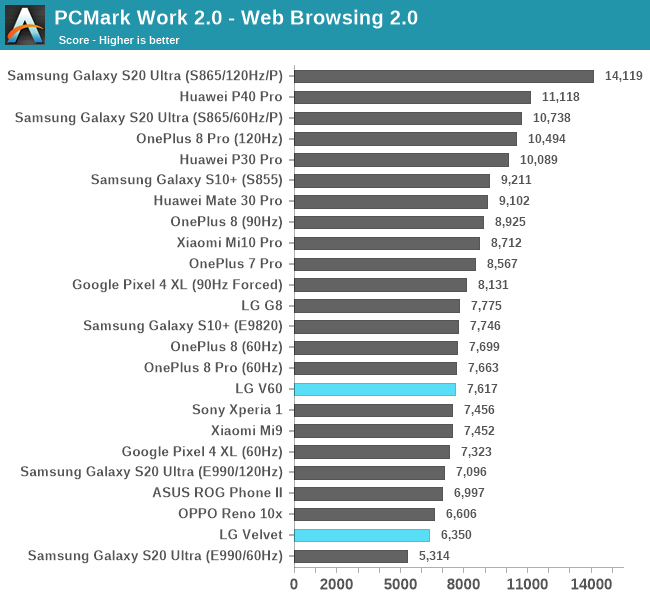
Starting off with the web browsing test in PCMark which is very sensible to performance responsiveness of the DVFS system, we see that the V60 and Velvet both fare quite averagely. The V60 is in line with the OnePlus 8 devices at 60Hz in this test which is pretty much what we’d expect, but that also means it’s also slower than last year’s G8, which seemingly didn’t have an as quite conservative software configuration.
The Velvet isn’t doing well at all and besides of the weirdly behaving S20 Ultra with the Exynos 990 at 60Hz, is the worst performing devices here.
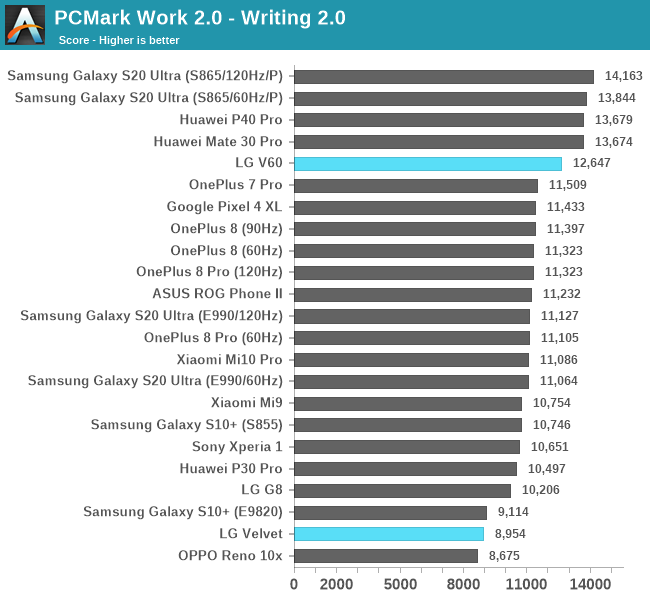
The writing sub-test which is generally more indicative of every-day performance of a device is again also quite contrasting between the two phones. The V60 fares well as is amongst the better performing Snapdragon 865 devices. The Velvet, which certainly not a slouch, compares more alike a 2018 flagship device in the scores.
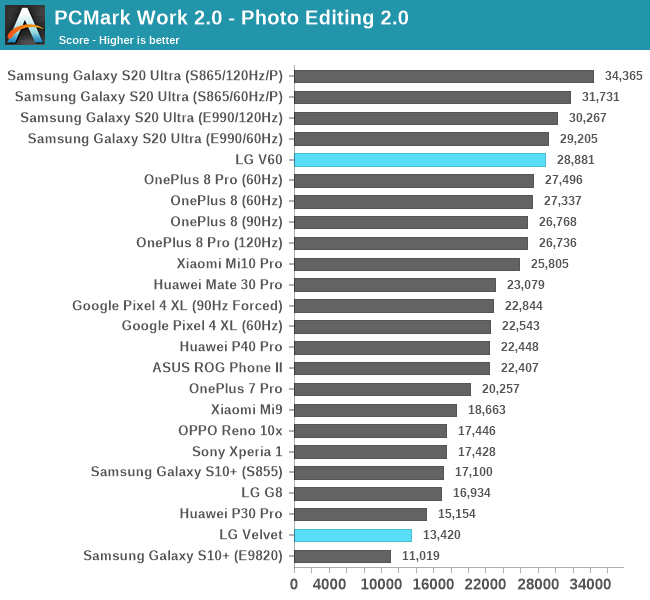
In the Photo Editing test which makes use of the GPU power, there’s a huge difference in performance between the two phones. Again the V60 is in line with other S865 devices, whilst the Velvet tends to really lag behind the pack with its weaker GPU.
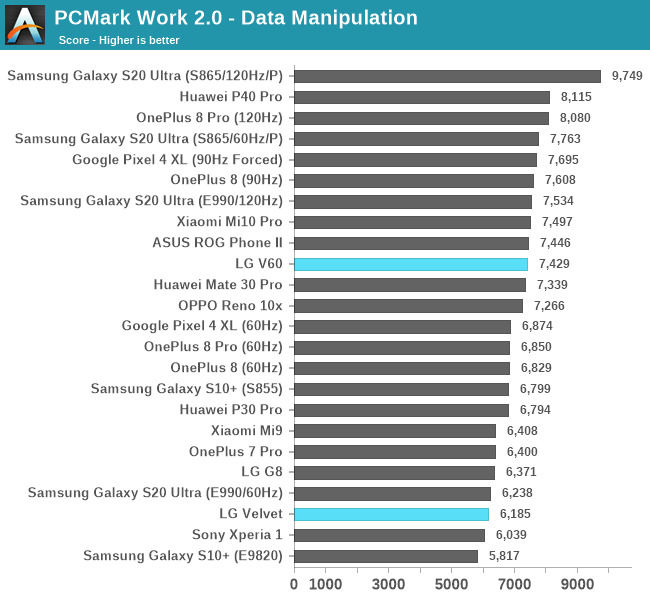
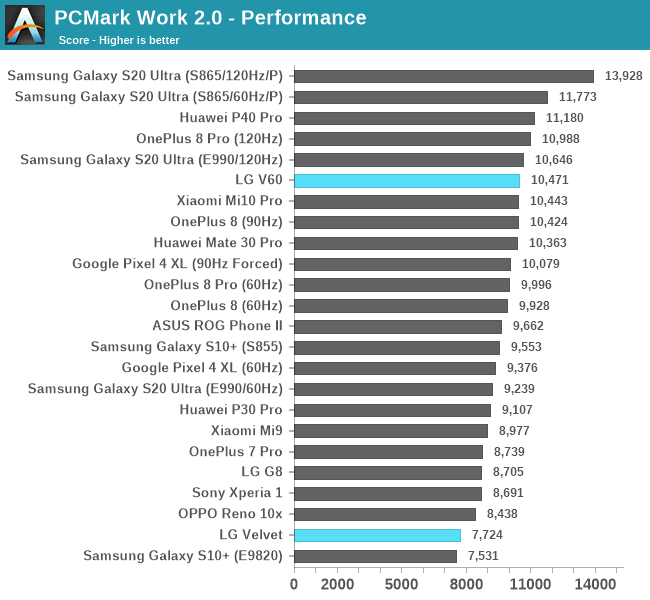
Overall, in PCMark, we see the V60 ending up on par with other 2020 flagship devices, although not quite able to best Samsung’s software optimisations. The Velvet is as expected a lower performing device, but it’s still quite a notable difference in the scores.
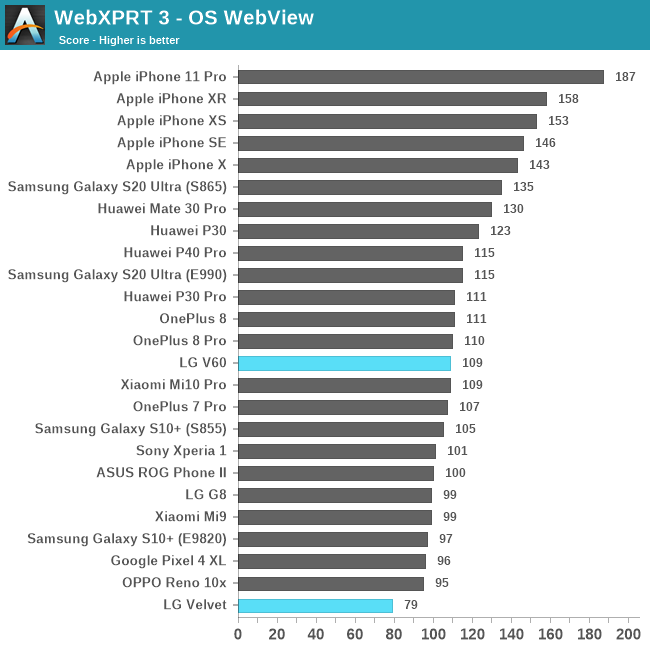
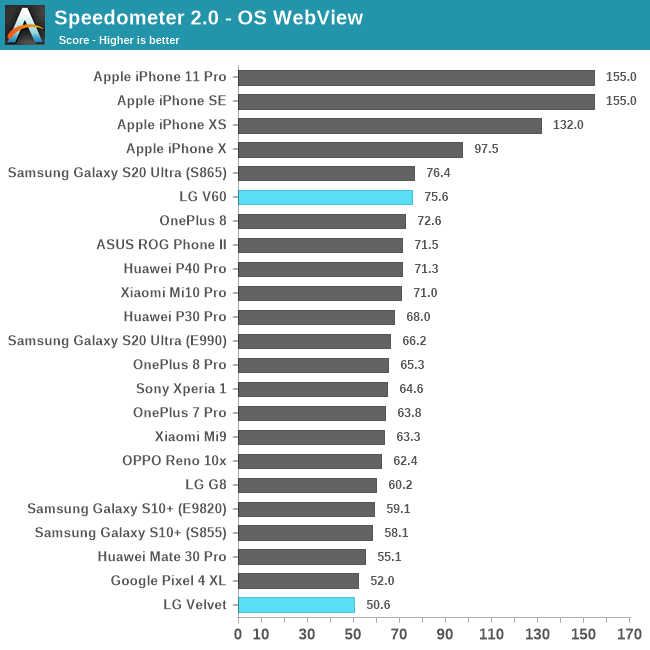
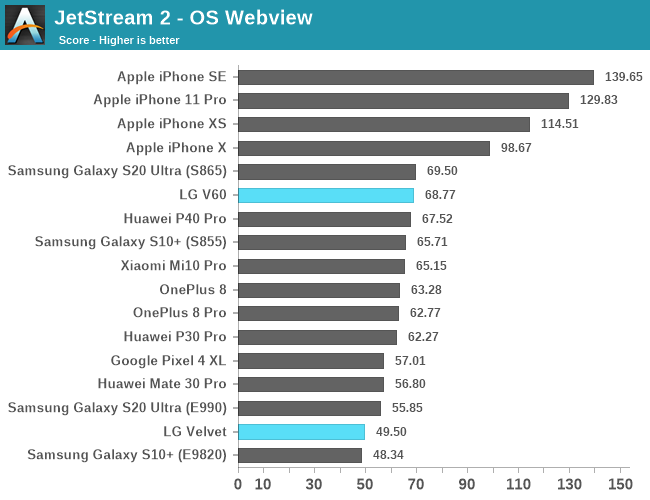
In the web-browsing and Javascipt browser tests, things are largely bottlenecked by the single-threaded performance of the CPUs of the SoC. With the Snapdragon 765 using a Cortex-A76 at 2.3GHz peak, the end performance is naturally quite a bit less than the more expensive flagship silicon. Generally, it seems the SoC falls in somewhere between a Snapdragon 845 and 855 in terms of performance, which is right where you’d expect it to be.
Overall Performance
Overall, the LG V60 was a very good performer and offers amongst the best experiences in 2020 – although LG’s lack of a higher refresh rate screen does mean it doesn’t quite give the smoothness that other devices are able to provide – although that’s just a compromise between performance and battery life.
The LG Velvet was actually a bit disappointing for me, and it really reminded me that the processing power of today’s SoCs are actually being fully utilised for daily usage of the phones. It’s not that the Velvet was unusable or a slouch, but I immediately noticed that it wasn’t quite as well of a performer compared to say the V60. In general terms, I would say the phone feels more like a 2018 flagship device in terms of responsiveness.
GPU Performance
GPU performance of both the V60 and Velvet are also expected to be quite interesting, given the stark differences in the two SoCs. We don’t know too many details of the Adreno 620 and exactly how much less processing elements we have compared to the Adreno 650, but if the power draw of the phones during 3D workloads are any indication of the performance difference, the S765 should be less than half as performant compared to the S865.
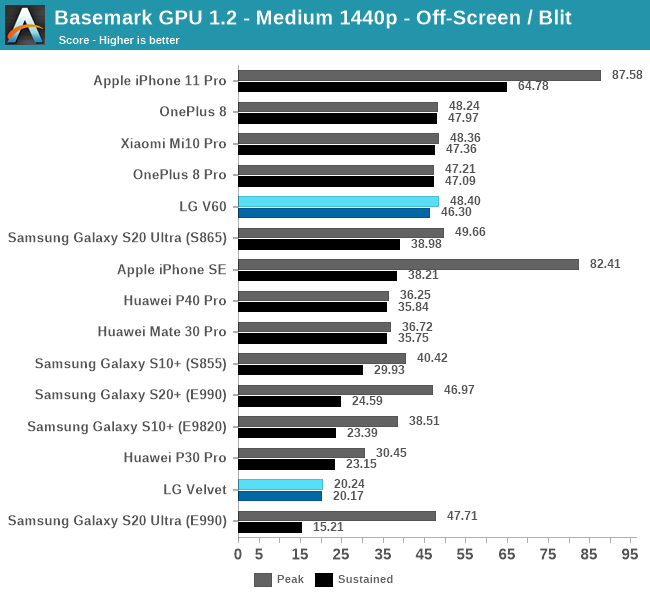
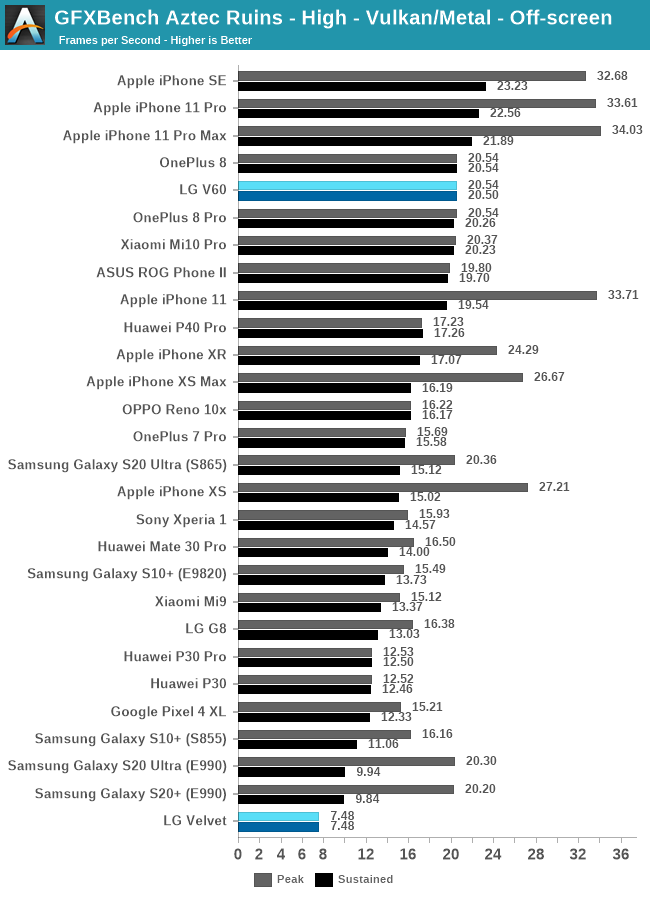
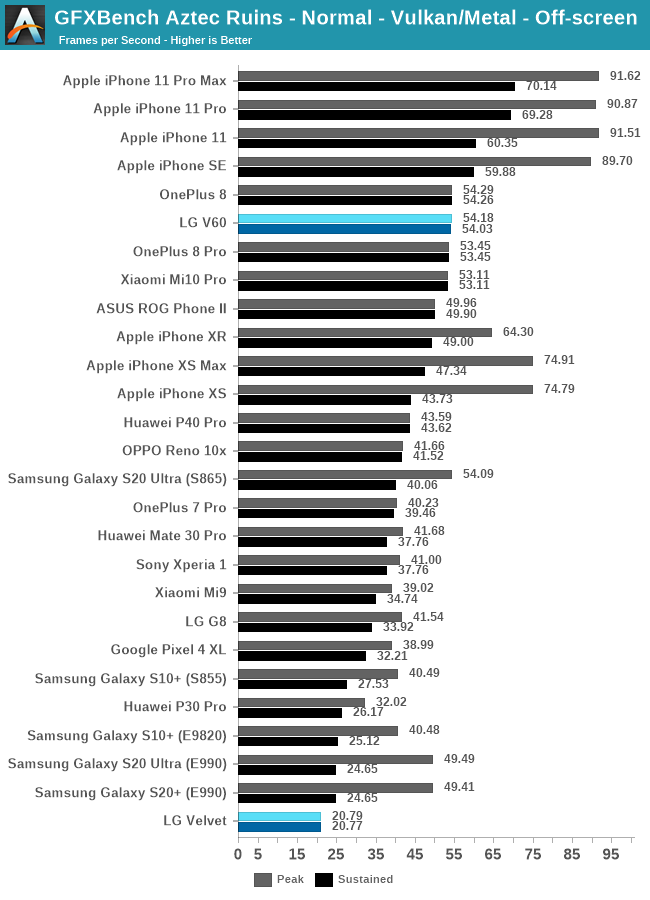
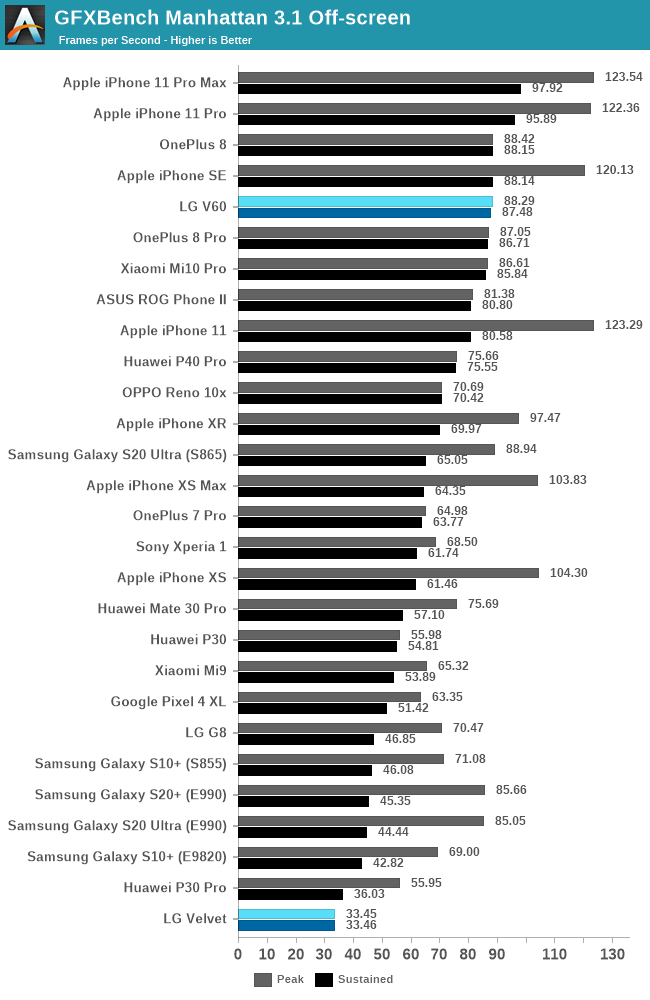
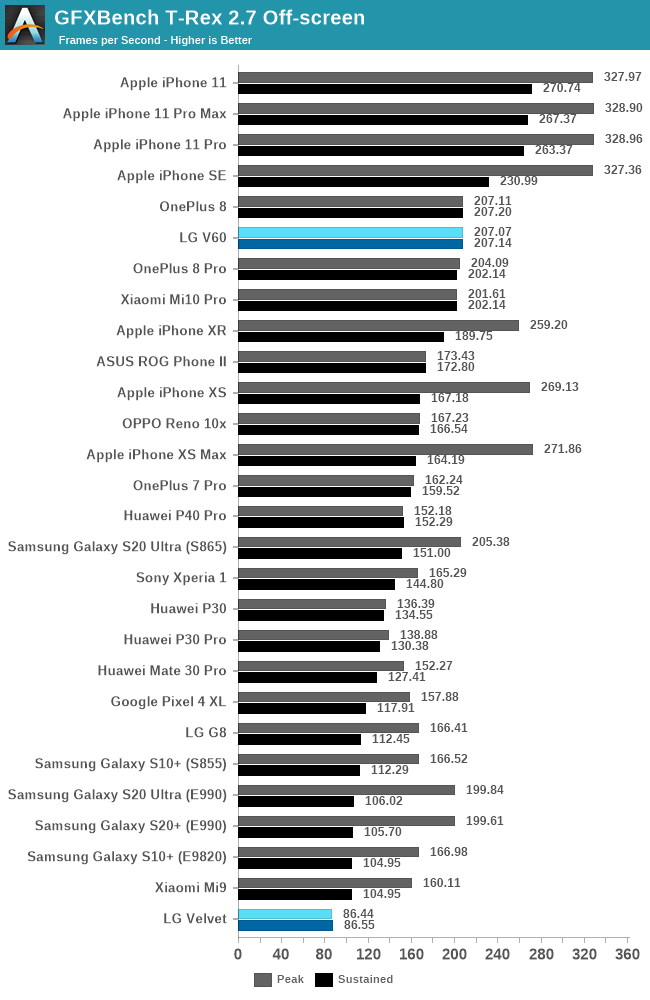
Indeed, in all our benchmarks, we see the LG Vevlet with the Snapdragon 765 roughly fare off about 2.5x slower than the Snapdragon 865. That’s a not too great result, and actually puts the new premium chipset in line with the peak performance of a Snapdragon 835 from a few years ago.
The good news here is the power draw of the phone – at around 1.7-1.8W active system load, the chipset is really only using a fraction of the power compared to the flagship SoCs, even the efficient Snapdragon 865. This means that thermal throttling is pretty much impossible for the chipset and the LG Velvet, making its sustained performance figures identical to its peak figures. In this regard, the chip and phone perform more similar to a Snapdragon 845 device, whilst only ever getting lukewarm at worst.
The LG V60’s more performant SoC falls in line with our latest batch of Snapdragon 865 phones. We’re seeing excellent performance and thermal behaviour, with the phone also nearly not throttling at all after prolonged periods – only reaching ~38°C peak skin temperatures.
Display Measurement - Typical LG
We mentioned that we have a high suspicion that the V60 and Velvet screen panels are identical, even though there’s a different shape cover glass over both. One further difference between the two phones is their software calibration. The V60 comes with LG’s classic wide range of display profiles (Auto, Cinema, Sports, Game, Photos, Web, Expert) that we’ve seen introduced over the last few years, whilst the Velvet has more significantly simplified things down to only three presents as a custom option (Natural, Vivid, Cinema, Custom).
For the V60, LG’s most accurate preset which actually targets an sRGB gamut is the “Web” profile and that’s what we tested here today. On the Velvet, it unfortunately looks like LG dumbed things down a little too much, as the phone no longer has any profile that’s able to target an sRGB gamut, with all of the available presets targeting some larger colour spaces. We’ve left it on the “Natural” mode as it gave a good enough white-point out of the box.
We move on to the display calibration and fundamental display measurements of the V60 and Velvet screens. As always, we thank X-Rite and SpecraCal, as our measurements are performed with an X-Rite i1Pro 2 spectrophotometer, with the exception of black levels which are measured with an i1Display Pro colorimeter. Data is collected and examined using Portrait Display's CalMAN software.
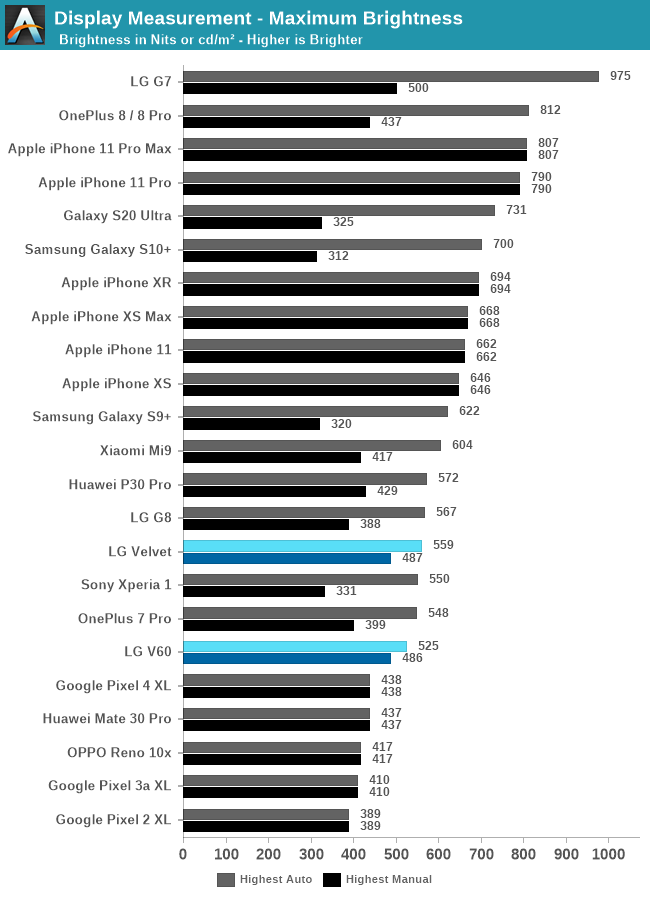
In terms of brightness, the new LG panels here don’t fare all too well in terms of their maximum brightness. In manual mode, both phones do get brighter than what we typical see of Android OLED devices at around 485 cd/m², but the auto mode under bright environments doesn’t raise this figure much at all, only reaching 525-550 cd/m² on both phones. The auto mode does change the colours and improves contrast for legibility, but can’t really compete with the newer generation Samsung AMOLED panels in terms of brightness.
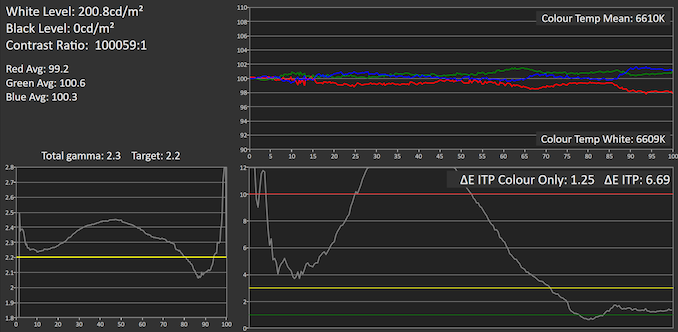
 Portrait Displays CalMAN
Portrait Displays CalMAN
LG V60
Moving on onto greyscale testing, the LG V60 has some large problems in terms of properly tracking a correct gamma curve. The mid-levels are far too dark, beyond reasonable error rates. The good news is that the colour balance and temperature on the phone is quite good and reaching whites and average colour temperatures of 6600K – a little bit cooler over the 6500K natural sunlight white target, but I prefer this to say Samsung’s usual too warm colour tones.
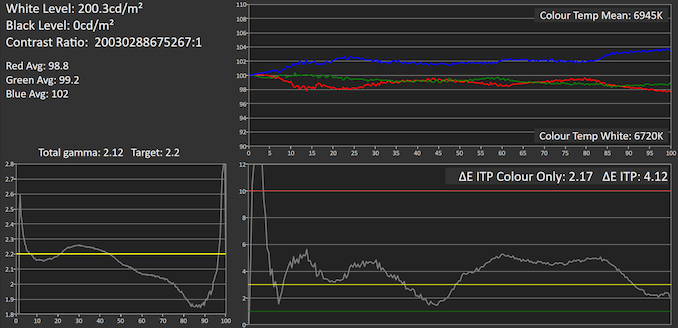
 Portrait Displays CalMAN
Portrait Displays CalMAN
LG Velvet
The LG Velvet’s greyscale results also have issues with the gamma tracking, but this time around it’s on the upper levels where it’s showcasing too low gamma, resulting in tones being brighter than they should be. The Natural colour profile here is also more noticeably cooler, with an average colour temperature of 6945K. It’s possible to fine-tune the colour temperature in the custom settings to alleviate this if it’s a bother.
In the saturations against an sRGB gamut, we see the LG V60 fare quite well when it comes to just the colours themselves. The phone’s biggest issue here is the aforementioned handling of the gamma, resulting in the tones being far too dark.
On the Velvet, as the phone doesn’t actually have a native accurate sRGB mode, it means that all the targets here are way off mark as the “Natural” gamut doesn’t correspond to any particular colour space. This also isn’t a P3 target as the blue hue is significantly different in hue – I don’t know precisely what LG is targeting here if they’re even targeting any standard at all.
In the GMB test with common test tones and colours, the V60 falls flat on its face as the results are outright disastrous. This isn’t too much of a surprise as LG has a long history of making a complete mess of their display colour calibrations in their phones, and the V60 is unfortunately just a continuation of that tradition.
The Velvet, oddly enough, actually fares quite well in the GMB test even though it really shouldn’t be given its non-sRGB gamut. The biggest noticeable difference in the comparison palette is that many of the patches are brighter than they should be, which again points out to the lower than should-be gamut calibration.
Overall, both phones are very clearly LG phones and their colour calibrations are amongst the worst in the market right now. The V60 in particular has just atrocious results given that this was supposed to be an accurate “Web” profile targeting the sRGB space. It’s really unfortunate what the company did here, but after so many years of seeing repeated disaster after disaster, I’ve just come to accept that LG phones simply won’t ever have accurate colours, as sad as that sounds.
Battery Life - Outstanding
Battery life has been an aspect where LG has had tons of issue in past generation devices. The root cause here was the company’s usage of LG Display manufactured displays, which all shared the same common issue of having extraordinarily bad base power consumption. This had always handicapped phones from achieving better results, more accurately tracking the SoC’s efficiency and the battery capacity.
The V60’s downgrade from 1440p to 1080p screen might help in that regard, and the manufacturer also opted to include a large 5000mAh battery. The Velvet’s 4300mAh battery should also fare adequately – here’s more of a question on whether the Snapdragon 765 is as efficient as its bigger brother.

In our web-browsing test, we see the LG V60 do outstandingly good, coming in at 14.75H runtime. This vastly exceeds the results of any LG phone we’ve come to test in the past, and competes amongst the longest lasting devices in the market right now. LG still seems to have not quite as an efficient display panel as Samsung, as the S20 Ultra’s 1440p unit is only margins behind the V60, but the gap has considerably narrowed.
The LG Velvet surprised us with equally impressive results. At 12.73 hours runtime, it’s also a great result given the phone’s battery capacity, and nearly scales in line with the 700mAh difference to the V60. This bodes well for the Snapdragon 765 overall, although we’ve seen that the CPU cores themselves aren’t as efficient as on the Snapdragon 865.
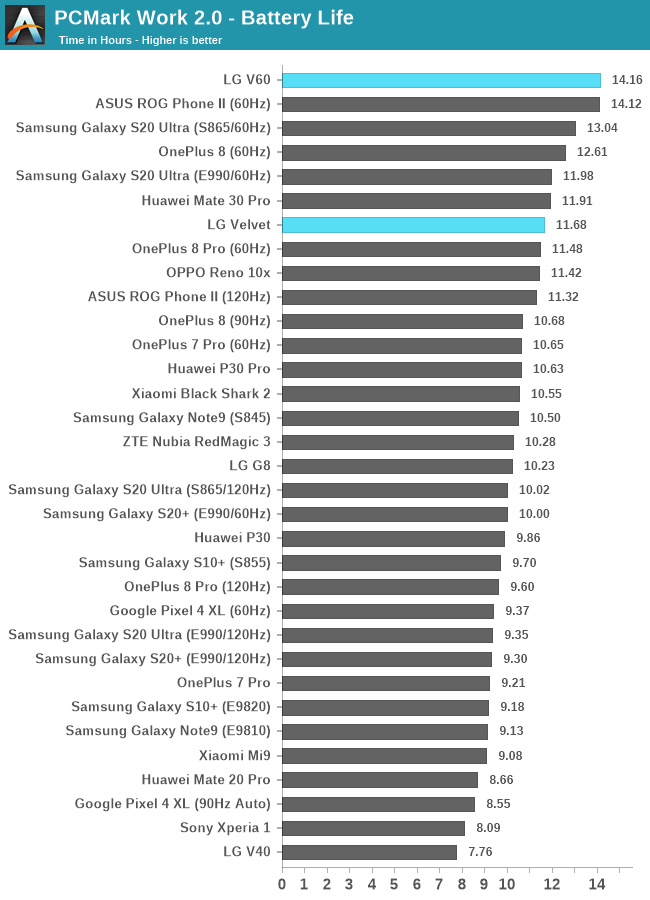
In PCMark, the V60 even manages to get the top spot in our charts by a few minutes against the 6000mAh ROG Phone II, and the Velvet also fares extremely well against the competition.
Overall, battery life of both the V60 and Velvet is outstandingly good. In a year where most other competitors have opted for higher refresh-rate displays, LG’s decision to keep things simple is rewarded by being able to take advantage of the new silicon’s power efficiency in order to notably increase battery life.
Camera Recap
A few weeks ago, we’ve published an extensive article comparing this first half year’s main flagship devices cameras, including the LG V60. I would recommend reading that piece for a more extensive conclusion on the camera system of the V60.
Read Our Extensive Camera Evaluation For More Samples:
Mobile Flagship Phone Camera Overview 2020 H1: Still Picture Battle

[ V60 ]
[ OnePlus 8 ] - [ OnePlus 8 Pro ]
[ iPhone 11 Pro ] - [ iPhone SE ] - [ Pixel 4 ]
[ Galaxy S20U(S) ] - [ Galaxy S20+(E) ]
[ Mi 10 Pro ]
[ Mate 30 Pro ] - [ P40 Pro ]
[ Reno3 Pro 5G ] - [ Reno3 Pro ]
[ X-T30 ]
In general LG has been able to showcase excellent results with the V60 in daylight photography, many times achieving amongst the best results in terms of detail thanks to the 64MP sensor that produces 16MP images.
LG’s HDR is pleasant and the phone has generally good colour reproduction.

[ V60 ]
[ OnePlus 8 ]
[ OnePlus 8 Pro ]
[ iPhone 11 Pro ] - [ iPhone SE ] - [ P4 ]
[ Galaxy S20U(S) ]
[ Galaxy S20+(E) ]
[ Mi 10 Pro ]
[ Mate 30 Pro ]
[ P40 Pro ]
[ Reno3 Pro 5G ]
[ Reno3 Pro ]
[ X-T30 ]
In terms of zooming, the lack of a telephoto module is compensated by the fact that the main camera is able to losslessly crop its 64MP images, although beyond 2-3x the results are not competitive with other phones with dedicated units.
The ultra-wide-angle module of the V60 is also good and amongst the top performers on the market.

[ V60 ]
[ OnePlus 8 ]
[ OnePlus 8 Pro ]
[ iPhone 11 Pro ] - [ iPhone SE ] - [ Pixel 4 ]
[ Galaxy S20U(S) ]
[ Galaxy S20+(E) ]
[ Mi 10 Pro ]
[ Mate 30 Pro ]
[ P40 Pro ]
[ Reno3 Pro 5G ]
[ Reno3 Pro ] - [ X-T30 ]
Low-light photography on the LG V60 is something solely depends on the amount of light available. In medium to lowish light the phone is able to perform fairly well, but the lack of a proper computational photography and night mode means that in darker scenarios the phone falls apart. It’s by far the biggest weak-point of the device when it comes to its camera system.
Read Our Extensive Camera Evaluation For More Samples:
Mobile Flagship Phone Camera Overview 2020 H1: Still Picture Battle
LG V60 vs LG Velvet
I haven’t had time to include the LG Velvet into a full camera comparison against the wider competition, however I did make some comparison shots against the V60 to be able to put the phone into context:
Overall, the Velvet’s camera results in terms of processing and composition is extremely similar to that of the V60, which is excellent news. Where the two phones differ is in terms of detail retention, and obviously the smaller and 48MP sensor of the Velvet here isn’t able to quite match the results of the V60.
There’s a slight dynamic range disadvantage for the Velvet, but nothing that you’d immediately pick up if you were to look at the images standalone. One more notable difference is that the colours on the Velvet are ever so slightly warmer, but again only noticeable in a few select scenarios when comparing the two phones against each other.
In general, the Velvet seems to have an excellent camera for a phone in this range, and I would say it easily beats some alternatives such as the mid-range OPPO phones, and has better processing than the OnePlus 8, with its biggest weakness again being low-light photography where the lack of a computational photography night mode is a big handicap.
Conclusion & End Remarks
Coming to the end of the review, we’re come to know to interesting devices from LG. The V60 and Velvet are two quite different devices that contrast LG’s seeming transition in device design, and for the most part, I’ve come to a generally positive impression from both phones.
Starting off with the LG V60, the first thing that is striking about the phone is that it’s a very non-contemporary design. Whilst most other manufacturers in 2020 have opted for curved screens and hole-punch front camera phones, LG has instead opted to seemingly remain in the past with a thick-bezeled notch design with a 2018-esque chamfered metal frame. Design is subjective, and practically besides of the ergonomics of a phone of this size, there’s nothing much wrong about keeping things simple like this – I’m pretty sure even a lot of people will enjoy the flat screen.
LG’s choice to go with a lower resolution screen when compared to the V50 is odd if one wouldn’t be familiar with LG past issues with battery life. I think the mobile division’s choice in downgrading the resolution is pretty much an admission that LG’s display division isn’t able to provide them with an efficient 1440p panel. I think this downgrade, as much as it’s painful for display fidelity, is the much better choice for the V60 as it finally solves the battery problem, and combined with the Snapdragon 865 and a 5000mAh makes the V60 amongst the longest lasting devices on the market today.
The lack of a high refresh-rate panel is a pity in 2020 – so that’s one of the compromises one has to make when going with the phone. Another big weakness is colour accuracy, and the V60 here is just horrible, but sadly we’ve come to expect that from LG phones.
Performance of the phone is great thanks to the S865 – it’s on par with other devices and results in a good user experience. I feel like LG’s software here can use a ton more polish in terms of their animations and general snappiness, but it’s not the phone itself which lacks processing power.
On the camera side of things, LG’s daylight pictures are excellent and easily amongst the top performers on the market. I really love what they did with the 64MP main camera sensor and it really is very detail-rich with good processing. The biggest weakness is low-light photography when it gets darker beyond a certain point, and the company’s lack of a proper computational photography night mode means it can’t compete with the rest of the pack when it gets very dark.
The LG Velvet is an interesting phone. First of all, LG’s redesign is a resounding success, and this is by far the sexiest LG phone we’ve come to experience in years. The company has always tried to be different in terms of their designs, but to be honest, there’s only so many ways to design a glass sandwich slab. For me the ergonomics of the phone are infinitely better than the V60 even though both devices share the same screen diagonal.
It’s also a 1080p screen, but here given that it’s a upper-mid-range / premium positioned device, I feel that it’s adequate enough for its class.
The Snapdragon 765 is new for a lot of people, and whilst it’s not my first encounter with the SoC, it’s the first comparison I was able to make against the S865 against a device from the same vendor, meaning the software stack and optimisations are similar. The end-result is probably a bit more disappointing than I had hoped it to be: On the CPU side, the chip generally performs in-between a Snapdragon 845 and a Snapdragon 855. Whilst I would no way say that it’s a bad user experience, there’s a clear difference in performance to the flagship V60.
On the GPU side, I feel like the difference is quite bigger, and here the phone performs in-between a Snapdragon 835 and 845 flagship phones when it comes to the performance, almost 2.5x slower than the Snapdragon 865 powered V60. That’s quite a starker difference, and if you’re a heavy gamer, it might not be the wisest purchase, versus say, just buying an older flagship phone.
Camera wise, the Velvet actually performed very well, and its best characteristics are that the processing is extremely similar to that of the V60, which means it’s quite excellent. Of course, the inferior sensor does mean slightly less details, dynamic range, and low-light photography is still a no-go, but at this price range it’s still reasonable enough.
Availability Is The Handicap
The LG V60’s release price was $899 which actually undercut a lot of other Snapdragon 865 phones in the market at the time, at least Samsung’s devices. The phone’s strengths are its outstanding battery life and a strong daylight camera. Weaknesses are a more lacklustre screen and a worse very low-light camera system. Unique things about the phone are its inclusion of a 3.5mm headphone jack. In general, the competition at this price would the OnePlus 8 Pro, which admittedly just offers a much better overall package, only sacrificing some battery life and the 3.5mm jack. I feel like LG would need a $100 price cut to make the V60 a more rationalised purchase.
The LG Velvet comes in at 599€. Whilst the phone its generally good for its price-point, the biggest issue I have with these premium devices is that 90% of the time you’re just better off buying last year’s flagship phones. A Galaxy S10 right now undercuts the Velvet at 555€ whilst being a much better phone with a better display, more performance, and overall better camera system. The only thing where the Velvet really is able to claim victory over last year’s devices is its 5G connectivity which future-proofs the phone significantly. In that sense, I also feel that the device is slightly overpriced as-is, and a 100€ reduction would alleviate any hesitations for its purchase. OnePlus’s upcoming Nord device seemingly will have very similar specifications to the Velvet while we’re expecting it to come at a lower price as well.
LG’s biggest issues today however isn’t merely pricing, but also availability. The V60 was never released in Europe and in the US it’s most commonly available only from select carriers. My review unit is actually T-Mobile branded phone and it comes with the usual bloatware associated with that.
The Velvet just outright isn’t available in the US, so you’ll have no luck in getting a device there. The phone was recently released in Europe with wider availability, as you can for example just buy a unit off LG directly from Amazon for example.
Overall, both phones aren’t the most competitive phones, but they’re still LG’s best phones they have made to date, and are both definitive improvements of the company’s past attempts. Let’s hope the Velvet’s fresh redesign can also be applied to other future LG devices.

